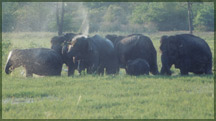|
DAILY NEWS ONLINE |
|
|
|
OTHER EDITIONS |
|
|
|
|
|
|
|
|
|
OTHER LINKS |
|
|
|
|
|
|
 |
Villagers-vital for conservation
A few weeks ago enraged villagers stormed the office of the Wild Life Department at the entrance to Yala National Park. In the melee that ensued, Department staff were forced to open fire at the crowd to control them and one villager died. Many villagers are still languishing in remand custody of the Police for inciting such mob violence upon a government department. Relations between the Department of Wildlife and the people around any protected areas are never hunky dory. But this incident represented one of the worst conflicts between the protectors of our wildlife heritage and villagers of the vicinity.
The people living in a nearby village were terrorized by elephant attacks and two people were killed in the past few months by elephants, maybe even by the same bull. Villagers were angry because their appeals for help to the Department appeared to have fallen on deaf ears. While many of us living and working in urban or semi-urban areas harbour a somewhat romantic view of elephants and feel very strongly and emotionally about the animals and their survival in the wild, this is not so of people who are forced to live with elephants. In a large part of the dry-zone, villagers battle daily with elephants, trying to protect their crop, their homes and their gardens from the jumbos. What is now better known as the human-elephant conflict takes a dangerously high toll on the poor dry-zone farmer. A recent study assesses the annual crop damage at over one billion rupees. There are other indirect costs too. Children cannot attend school on time, transport along certain rural roads is disturbed and at times people have to abandon their homes and traditional land holdings due to elephant trouble. Animosity towards the elephant is rife in areas where humans have to daily live with the fear of crop or property damage and especially since they feel that the State's attitude is more benevolent towards the elephant. Wildlife staff and officers have traditionally had problems of relating to the villagers. There is mutual dislike and mistrust between the two. Villagers feel that the Department should bear the responsibility of controlling elephants, especially since they see the Department as the custodian and protector of elephants. But the Department's job is made more complicated by the fact that almost 70 per cent of wild elephants range outside of officially sanctioned protected areas. Who should protect whom? Current knowledge on elephant management emphasies the role of villagers and communities that live with elephants in their protection. It would be ideal if villagers themselves saw the worth of elephants and took it upon themselves to protect the animals. But this is not achieved in the present scenario. The villagers cannot be blamed-to them the elephant spells nothing but trouble. And worse elephants are protected by a State which displays little sympathy towards the people who are plagued by this problem. Should the Department protect villagers as well? When there are complaints of marauding elephants in a habituated area, the Department is bound to find some solution to the problem. But as conservationists are aware, the solutions are often short-term and ad hoc. Electric fencing, drives, capture and translocation are all solutions that the department employs to control human-elephant conflict- but these are not long-term nor sustainable. They are better as short-term public relations exercises rather than real solutions. The Wild Life Department realised some time ago that they need to be more attuned to the villagers' concerns and feeling and build a good rapport with the surrounding communities. It is known world over that without the active participation or at least tacit support of villagers around a protected area, conservation is impossible. There have been some effort to work with villagers but events like what happened in Yala last month will set the programme back by years. |
|
|


